在网上已经有跟多Bean的生命周期的博客,但是很多都是基于比较老的版本了,最近吧整个流程化成了一个流程图。待会儿使用流程图,说明以及代码的形式来说明整个声明周期的流程。注意因为代码比较多,这里的流程图只画出了大概的流程,具体的可以深入代码
一、获取Bea
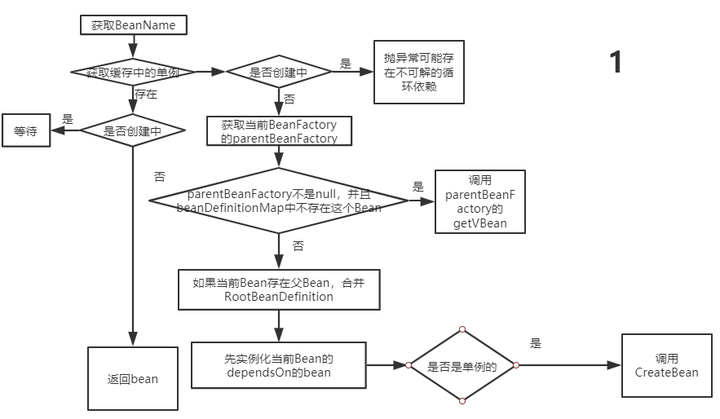
第一阶段获取Bean
这里的流程图的入口在 AbstractBeanFactory类的 doGetBean方法,这里可以配合前面的 getBean方法分析文章进行阅读。主要流程就是
1、先处理Bean 的名称,因为如果以“&”开头的Bean名称表示获取的是对应的FactoryBean对象;
2、从缓存中获取单例Bean,有则进一步判断这个Bean是不是在创建中,如果是的就等待创建完毕,否则直接返回这个Bean对象
3、如果不存在单例Bean缓存,则先进行循环依赖的解析
4、解析完毕之后先获取父类BeanFactory,获取到了则调用父类的getBean方法,不存在则先合并然后创建Bean
二、创建Bean
2.1 创建Bean之前
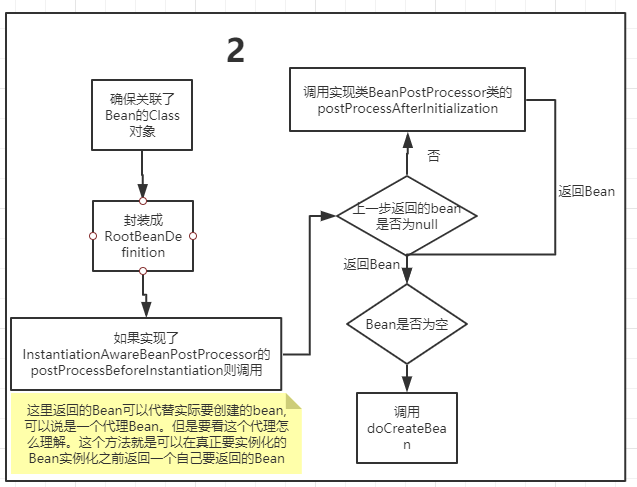
在真正创建Bean之前逻辑
这个流程图对应的代码在 AbstractAutowireCapableBeanFactory类的 createBean方法中。
1、这里会先获取 RootBeanDefinition对象中的Class对象并确保已经关联了要创建的Bean的Class 。整编:微信公众号,搜云库技术团队,ID:souyunku
2、这里会检查3个条件
(1)Bean的属性中的 beforeInstantiationResolved字段是否为true,默认是false。
(2)Bean是原生的Bean
(3)Bean的 hasInstantiationAwareBeanPostProcessors属性为true,这个属性在Spring准备刷新容器钱转杯BeanPostProcessors的时候会设置,如果当前Bean实现了 InstantiationAwareBeanPostProcessor则这个就会是true。
当三个条件都存在的时候,就会调用实现的 InstantiationAwareBeanPostProcessor接口的 postProcessBeforeInstantiation方法,然后获取返回的Bean,如果返回的Bean不是null还会调用实现的 BeanPostProcessor接口的 postProcessAfterInitialization方法,这里用代码说明
protected Object resolveBeforeInstantiation(String beanName, RootBeanDefinition mbd) { Object bean = null; //条件1 if (!Boolean.FALSE.equals(mbd.beforeInstantiationResolved)) { //条件2跟条件3 if (!mbd.isSynthetic() && hasInstantiationAwareBeanPostProcessors()) { Class<?> targetType = determineTargetType(beanName, mbd); if (targetType != null) { //调用实现的postProcessBeforeInstantiation方法 bean = applyBeanPostProcessorsBeforeInstantiation(targetType, beanName); if (bean != null) { //调用实现的postProcessAfterInitialization方法 bean = applyBeanPostProcessorsAfterInitialization(bean, beanName); } } } //不满足2或者3的时候就会设置为false mbd.beforeInstantiationResolved = (bean != null); } return bean; }
1、如果上面3个条件其中一个不满足就不会调用实现的方法。默认这里都不会调用的这些 BeanPostProcessors的实现方法。然后继续执行后面的 doCreateBean方法。
2.1 真正的创建Bean,doCreateBean
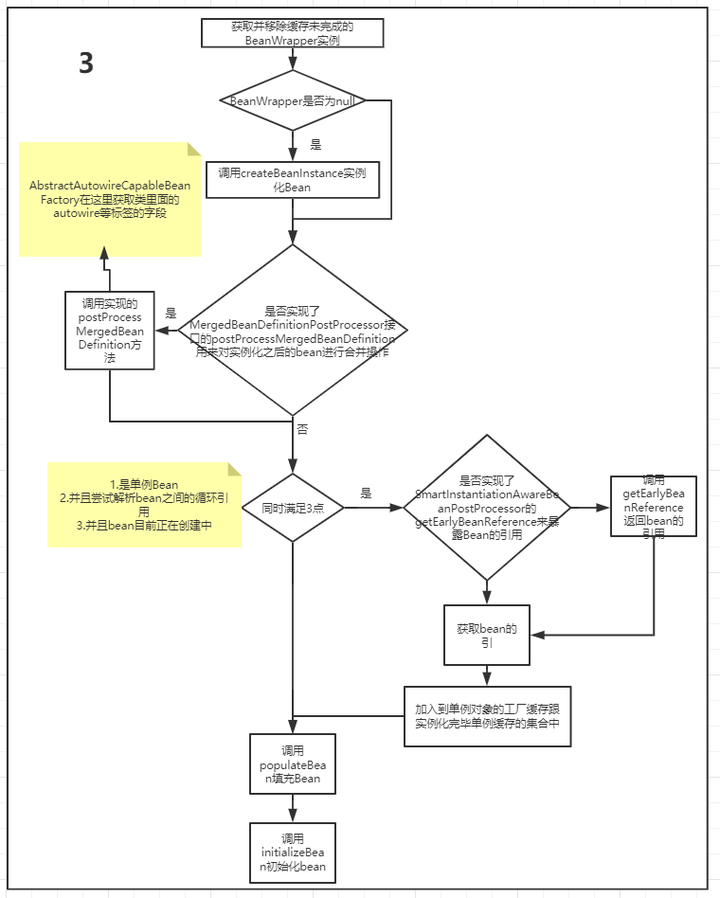
doCreateBean方法逻辑
这个代码的实现还是在 AbstractAutowireCapableBeanFactory方法中。流程是
1、先检查 instanceWrapper变量是不是null,这里一般是null,除非当前正在创建的Bean在 factoryBeanInstanceCache中存在这个是保存还没创建完成的FactoryBean的集合。
2、调用createBeanInstance方法实例化Bean,这个方法在后面会讲解
3、如果当前 RootBeanDefinition对象还没有调用过实现了的 MergedBeanDefinitionPostProcessor接口的方法,则会进行调用 。整编:微信公众号,搜云库技术团队,ID:souyunku
4、 当满足以下三点
(1)是单例Bean
(2)尝试解析bean之间的循环引用
(3)bean目前正在创建中
则会进一步检查是否实现了 SmartInstantiationAwareBeanPostProcessor接口如果实现了则调用是实现的 getEarlyBeanReference方法 5、 调用 populateBean方法进行属性填充,这里后面会讲解 6、 调用 initializeBean方法对Bean进行初始化,这里后面会讲解
2.1.1 实例化Bean,createBeanInstance
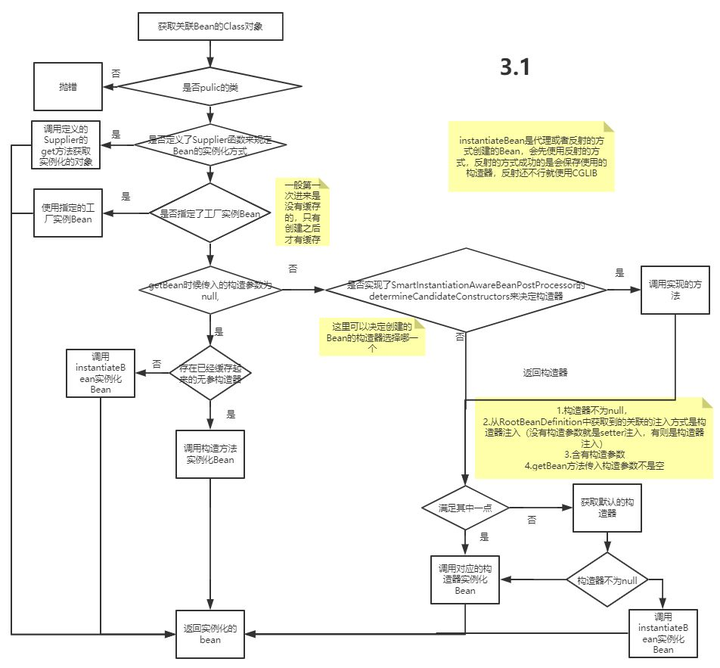
实例化Bean
这里的逻辑稍微有一点复杂,这个流程图已经是简化过后的了。简要根据代码说明一下流程
protected BeanWrapper createBeanInstance(String beanName, RootBeanDefinition mbd, @Nullable Object[] args) { //步骤1 Class<?> beanClass = resolveBeanClass(mbd, beanName); if (beanClass != null && !Modifier.isPublic(beanClass.getModifiers()) && !mbd.isNonPublicAccessAllowed()) { throw new BeanCreationException(mbd.getResourceDescription(), beanName, "Bean class isn't public, and non-public access not allowed: " + beanClass.getName()); } //步骤2 Supplier<?> instanceSupplier = mbd.getInstanceSupplier(); if (instanceSupplier != null) { return obtainFromSupplier(instanceSupplier, beanName); } //步骤3 if (mbd.getFactoryMethodName() != null) { return instantiateUsingFactoryMethod(beanName, mbd, args); } boolean resolved = false; boolean autowireNecessary = false; if (args == null) { synchronized (mbd.constructorArgumentLock) { if (mbd.resolvedConstructorOrFactoryMethod != null) { resolved = true; autowireNecessary = mbd.constructorArgumentsResolved; } } } //步骤4.1 if (resolved) { if (autowireNecessary) { return autowireConstructor(beanName, mbd, null, null); } else { return instantiateBean(beanName, mbd); } } //步骤4.2 Constructor<?>[] ctors = determineConstructorsFromBeanPostProcessors(beanClass, beanName); if (ctors != null || mbd.getResolvedAutowireMode() == AUTOWIRE_CONSTRUCTOR || mbd.hasConstructorArgumentValues() || !ObjectUtils.isEmpty(args)) { return autowireConstructor(beanName, mbd, ctors, args); } //步骤5 ctors = mbd.getPreferredConstructors(); if (ctors != null) { return autowireConstructor(beanName, mbd, ctors, null); } return instantiateBean(beanName, mbd); }
1、先检查Class是否已经关联了,并且对应的修饰符是否是public的
2、如果用户定义了Bean实例化的函数,则调用并返回
3、如果当前Bean实现了 FactoryBean接口则调用对应的 FactoryBean接口的 getObject方法
4、根据getBean时候是否传入构造参数进行处理
4.1 如果没有传入构造参数,则检查是否存在已经缓存的无参构造器,有则使用构造器直接创建,没有就会调用 instantiateBean方法先获取实例化的策略默认是 CglibSubclassingInstantiationStrategy,然后实例化Bean。最后返回
4.2 如果传入了构造参数,则会先检查是否实现了 SmartInstantiationAwareBeanPostProcessor接口,如果实现了会调用 determineCandidateConstructors获取返回的候选构造器。整编:微信公众号,搜云库技术团队,ID:souyunku
4.3 检查4个条件是否满足一个
(1)构造器不为null,
(2)从RootBeanDefinition中获取到的关联的注入方式是构造器注入(没有构造参数就是setter注入,有则是构造器注入)
(3)含有构造参数
(4)getBean方法传入构造参数不是空
满足其中一个则会调用返回的候选构造器实例化Bean并返回,如果都不满足,则会根据构造参数选则合适的有参构造器然后实例化Bean并返回
5、如果上面都没有合适的构造器,则直接使用无参构造器创建并返回Bean。
2.1.2 填充Bean,populateBean
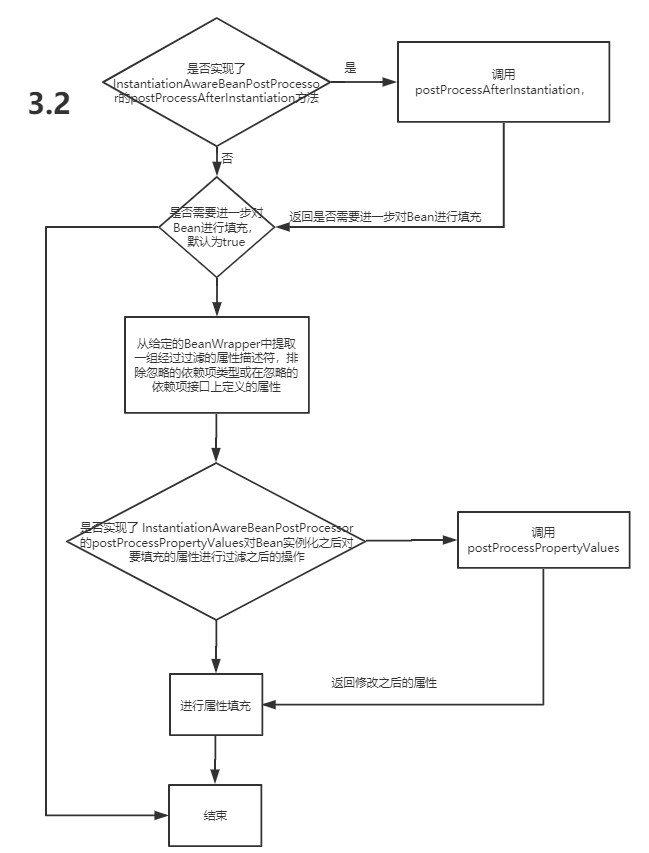
填充Bean
这里还是根据代码来说一下流程
protected void populateBean(String beanName, RootBeanDefinition mbd, @Nullable BeanWrapper bw) { if (bw == null) { if (mbd.hasPropertyValues()) { throw new BeanCreationException( mbd.getResourceDescription(), beanName, "Cannot apply property values to null instance"); } else { // Skip property population phase for null instance. return; } }
boolean continueWithPropertyPopulation = true; //步骤1 if (!mbd.isSynthetic() && hasInstantiationAwareBeanPostProcessors()) { for (BeanPostProcessor bp : getBeanPostProcessors()) { if (bp instanceof InstantiationAwareBeanPostProcessor) { InstantiationAwareBeanPostProcessor ibp = (InstantiationAwareBeanPostProcessor) bp; if (!ibp.postProcessAfterInstantiation(bw.getWrappedInstance(), beanName)) { continueWithPropertyPopulation = false; break; } } } } if (!continueWithPropertyPopulation) { return; } //步骤2-------------------- PropertyValues pvs = (mbd.hasPropertyValues() ? mbd.getPropertyValues() : null); int resolvedAutowireMode = mbd.getResolvedAutowireMode(); if (resolvedAutowireMode == AUTOWIRE_BY_NAME || resolvedAutowireMode == AUTOWIRE_BY_TYPE) { MutablePropertyValues newPvs = new MutablePropertyValues(pvs); // Add property values based on autowire by name if applicable. if (resolvedAutowireMode == AUTOWIRE_BY_NAME) { autowireByName(beanName, mbd, bw, newPvs); } // Add property values based on autowire by type if applicable. if (resolvedAutowireMode == AUTOWIRE_BY_TYPE) { autowireByType(beanName, mbd, bw, newPvs); } pvs = newPvs; } boolean hasInstAwareBpps = hasInstantiationAwareBeanPostProcessors(); boolean needsDepCheck = (mbd.getDependencyCheck() != AbstractBeanDefinition.DEPENDENCY_CHECK_NONE); PropertyDescriptor[] filteredPds = null; //步骤3 if (hasInstAwareBpps) { if (pvs == null) { pvs = mbd.getPropertyValues(); } for (BeanPostProcessor bp : getBeanPostProcessors()) { if (bp instanceof InstantiationAwareBeanPostProcessor) { InstantiationAwareBeanPostProcessor ibp = (InstantiationAwareBeanPostProcessor) bp; PropertyValues pvsToUse = ibp.postProcessProperties(pvs, bw.getWrappedInstance(), beanName); if (pvsToUse == null) { if (filteredPds == null) { filteredPds = filterPropertyDescriptorsForDependencyCheck(bw, mbd.allowCaching); } pvsToUse = ibp.postProcessPropertyValues(pvs, filteredPds, bw.getWrappedInstance(), beanName); if (pvsToUse == null) { return; } } pvs = pvsToUse; } } } if (needsDepCheck) { if (filteredPds == null) { filteredPds = filterPropertyDescriptorsForDependencyCheck(bw, mbd.allowCaching); } checkDependencies(beanName, mbd, filteredPds, pvs); } //步骤4 if (pvs != null) { applyPropertyValues(beanName, mbd, bw, pvs); } }
1、检查当前Bean是否实现了 InstantiationAwareBeanPostProcessor的 postProcessAfterInstantiation方法则调用,并结束Bean的填充。
2、将按照类型跟按照名称注入的Bean分开,如果注入的Bean还没有实例化的这里会实例化,然后放到 PropertyValues对象中。
3、如果实现了 InstantiationAwareBeanPostProcessor类的 postProcessProperties则调用这个方法并获取返回值,如果返回值是null,则有可能是实现了过期的 postProcessPropertyValues方法,这里需要进一步调用 postProcessPropertyValues方法
4、进行参数填充
2.1.3 初始化Bean,initializeBean
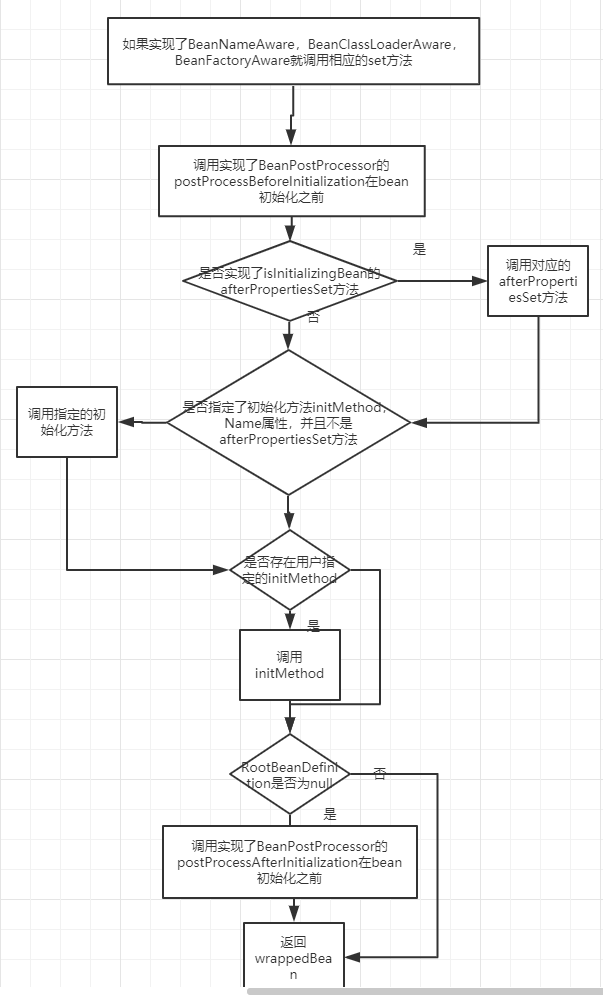
初始化Bean
同时这里根据代码跟流程图来说明
1、如果Bean实现了 BeanNameAware, BeanClassLoaderAware, BeanFactoryAware则调用对应实现的方法 。整编:微信公众号,搜云库技术团队,ID:souyunku
2、Bean不为null并且bean不是合成的,如果实现了 BeanPostProcessor的 postProcessBeforeInitialization则会调用实现的 postProcessBeforeInitialization方法。在 ApplicationContextAwareProcessor类中实现了 postProcessBeforeInitialization方法。而这个类会在Spring刷新容器准备 beanFactory的时候会加进去,这里就会被调用,而调用里面会检查Bean是不是 EnvironmentAware, EmbeddedValueResolverAware, ResourceLoaderAware, ApplicationEventPublisherAware, MessageSourceAware, ApplicationContextAware的实现类。这里就会调用对应的实现方法。代码如下
protected void prepareBeanFactory(ConfigurableListableBeanFactory beanFactory) { ....... beanFactory.addBeanPostProcessor(new ApplicationContextAwareProcessor(this)); .......
public Object postProcessBeforeInitialization(Object bean, String beanName) throws BeansException { if (!(bean instanceof EnvironmentAware || bean instanceof EmbeddedValueResolverAware || bean instanceof ResourceLoaderAware || bean instanceof ApplicationEventPublisherAware || bean instanceof MessageSourceAware || bean instanceof ApplicationContextAware)){ return bean; } AccessControlContext acc = null; if (System.getSecurityManager() != null) { acc = this.applicationContext.getBeanFactory().getAccessControlContext(); } if (acc != null) { AccessController.doPrivileged((PrivilegedAction<Object>) () -> { invokeAwareInterfaces(bean); return null; }, acc); } else { invokeAwareInterfaces(bean); } return bean; }
1、实例化Bean然后,检查是否实现了 InitializingBean的 afterPropertiesSet方法,如果实现了就会调用
2、Bean不为null并且bean不是合成的,如果实现了 BeanPostProcessor的 postProcessBeforeInitialization则会调用实现的 postProcessAfterInitialization方法。
到此创建Bean 的流程就没了,剩下的就是容器销毁的时候的了
三、destory方法跟销毁Bean
Bean在创建完毕之后会检查用户是否指定了 destroyMethodName以及是否实现了 DestructionAwareBeanPostProcessor接口的 requiresDestruction方法,如果指定了会记录下来保存在 DisposableBeanAdapter对象中并保存在bean的 disposableBeans属性中。代码在 AbstractBeanFactory的 registerDisposableBeanIfNecessary中
protected void registerDisposableBeanIfNecessary(String beanName, Object bean, RootBeanDefinition mbd) { ...... registerDisposableBean(beanName, new DisposableBeanAdapter(bean, beanName, mbd, getBeanPostProcessors(), acc)); ...... }
public DisposableBeanAdapter(Object bean, String beanName, RootBeanDefinition beanDefinition, List<BeanPostProcessor> postProcessors, @Nullable AccessControlContext acc) { ....... String destroyMethodName = inferDestroyMethodIfNecessary(bean, beanDefinition); if (destroyMethodName != null && !(this.invokeDisposableBean && "destroy".equals(destroyMethodName)) && !beanDefinition.isExternallyManagedDestroyMethod(destroyMethodName)) { ...... this.destroyMethod = destroyMethod; } this.beanPostProcessors = filterPostProcessors(postProcessors, bean); }
在销毁Bean的时候最后都会调用 AbstractAutowireCapableBeanFactory的 destroyBean方法。
public void destroyBean(Object existingBean) { new DisposableBeanAdapter(existingBean, getBeanPostProcessors(), getAccessControlContext()).destroy(); }
这里是创建一个 DisposableBeanAdapter对象,这个对象实现了Runnable接口,在实现的 run方法中会调用实现的 DisposableBean接口的 destroy方法。并且在创建 DisposableBeanAdapter对象的时候会根据传入的bean是否实现了 DisposableBean接口来设置 invokeDisposableBean变量,这个变量表实有没有实现 DisposableBean接口
public DisposableBeanAdapter(Object bean, List<BeanPostProcessor> postProcessors, AccessControlContext acc) { Assert.notNull(bean, "Disposable bean must not be null"); this.bean = bean; this.beanName = bean.getClass().getName(); //根据传入的bean是否实现了`DisposableBean`接口来设置`invokeDisposableBean`变量 this.invokeDisposableBean = (this.bean instanceof DisposableBean); this.nonPublicAccessAllowed = true; this.acc = acc; this.beanPostProcessors = filterPostProcessors(postProcessors, bean); } public void destroy() { ...... //根据invokeDisposableBean决定是否调用destroy方法 if (this.invokeDisposableBean) { if (logger.isTraceEnabled()) { logger.trace("Invoking destroy() on bean with name '" + this.beanName + "'"); } try { if (System.getSecurityManager() != null) { AccessController.doPrivileged((PrivilegedExceptionAction<Object>) () -> { ((DisposableBean) this.bean).destroy(); return null; }, this.acc); } else { ((DisposableBean) this.bean).destroy(); } } catch (Throwable ex) { String msg = "Invocation of destroy method failed on bean with name '" + this.beanName + "'"; if (logger.isDebugEnabled()) { logger.warn(msg, ex); } else { logger.warn(msg + ": " + ex); } } } ...... }
四、总结。
最后来一个大的流程
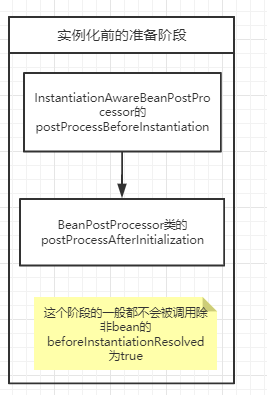
实例化前的准备阶段
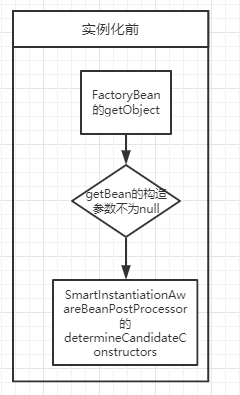
实例化前
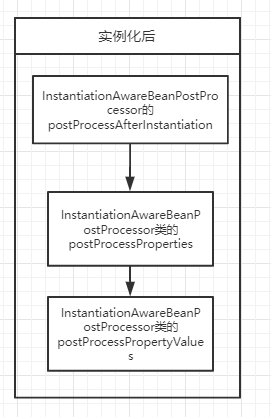
实例化后

初始化前
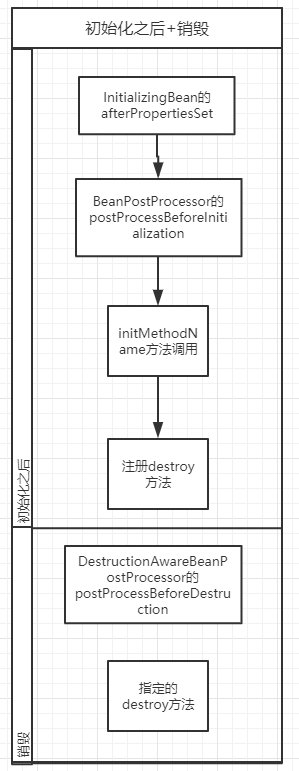
————————————————